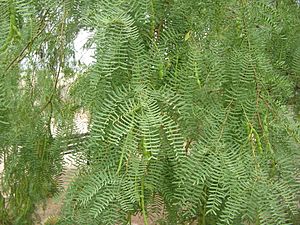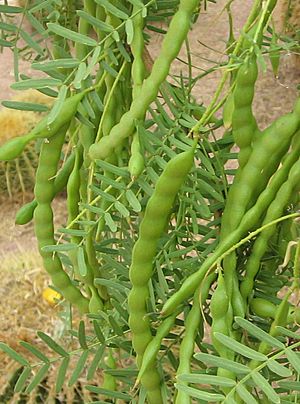Honey mesquite facts for kids
Quick facts for kids Honey mesquite |
|
|---|---|
 |
|
| Foliage with seedpods | |
| Conservation status | |
| Scientific classification | |
| Genus: |
Prosopis
|
| Species: |
glandulosa
|
| Varieties | |
|
Prosopis glandulosa var. glandulosa |
|
 |
|
| Natural range | |
| Synonyms | |
|
Prosopis juliflora var. glandulosa (Torr.) |
|
Prosopis glandulosa, also known as honey mesquite, is a type of small to medium-sized tree or thorny bush. It belongs to the legume family, which includes plants like beans and peas. This plant is known for its sweet-smelling flowers and tasty seedpods.
Contents
Where Honey Mesquite Grows
Honey mesquite is mostly found in the Southwestern United States and Northern Mexico. You can see it growing from Texas all the way up to southern Kansas. It also grows west into southern California.
It is a common plant in the Sonoran Desert. This desert covers parts of California, Arizona (in the U.S.), and Sonora state (in México).
What Honey Mesquite Looks Like
Honey mesquite trees have big, rounded branches that often droop down. Their leaves look like feathers. The twigs have straight, sharp spines that grow in pairs.
This tree usually grows about 6 to 9 meters (20 to 30 feet) tall. But some can reach up to 15 meters (50 feet)! It grows at a medium speed.
Flowers and Seeds
Honey mesquite flowers from March to November. Its flowers are pale yellow and grow in long spikes. After flowering, it produces straight, yellow seedpods.
Many animals enjoy eating these seeds. For example, scaled quail eat the seeds. Other animals like deer, collared peccaries, coyotes, and jackrabbits eat both the pods and the leaves.
Honey Mesquite as an Invasive Species
Honey mesquite has been brought to other countries on purpose. These include Australia, Botswana, Namibia, and South Africa. In these places, it is considered an invasive species. This means it grows too much and can harm the local environment.
The IUCN says it is one of the world's 100 worst invasive species. This is true when it grows outside its natural habitat.
The seeds spread easily when animals eat the sweet pods and then move to new areas. The plants can take over grasslands. Ranchers often see mesquites as weeds they need to remove. It is hard to get rid of them completely. If you cut a single-trunked tree, many new trunks can grow from underground buds.
How People Use Honey Mesquite
Honey mesquite plants are useful in many ways. They provide shelter for wildlife and materials for nests. Their seed pods are a seasonal food for many birds and small mammals.
For Pollinators and Food
As its name suggests, honey mesquite is a great honey plant. It helps feed native pollinator bees and other insects. It also supports honey bees that are raised by people. Butterflies like the long-tailed skipper and Reakirt's blue use it as a place for their young to grow.
Mesquite flour can be made from the pods. This flour has lots of protein and carbohydrates. You can use it in recipes instead of wheat flour.
In Namibia, even though it's an invasive plant, it's useful. It grows very fast, provides lots of shade, and its pods are plentiful. It is also a good source of firewood.
Used by Indigenous Peoples
The indigenous peoples of California and southwestern North America used honey mesquite in many ways. They used it as a medicinal plant, a food source, and for building and tools. They also used it for fuel.
The Cahuilla people ate the blossoms and pods. They would grind the pods into a meal to make a cake. The thorns were used as tattoo needles. The ashes from the plant were used for tattoos by the Cahuilla and Serrano Indians of Southern California.
The wood of the honey mesquite is very strong and hard. It was used to make tools and arrow points. It also gives a special flavor to food cooked over it. The deep roots, which are often bigger than the trunks, were dug up for firewood.
The Seri people of northwestern Mexico called this mesquite haas. It was very important for both food and other uses. The Seris had different names for the mesquite pod at each stage of its growth. Historically, it was a vital wild food plant because it produced fruit even during dry years.
See also
 In Spanish: Prosopis glandulosa para niños
In Spanish: Prosopis glandulosa para niños



